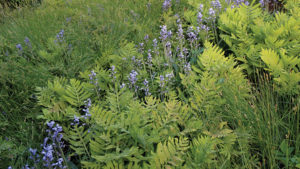Kelly Norris: Why the Plant Experience Really Matters With Young Consumers

The demand for Carex is growing, in part due to its functionality in the landscape. Photo by Kelly Norris
If there’s a phrase that seems to have simmered in the collective horticultural conscience in the post-Great Recession years, it’s “plants with a purpose.” It’s heard from talking heads on stages at conferences around the country and bandied about as a new ruler, perhaps shoved only halfway up our consumer’s sleeves. Could it be the new “thriller, filler, spiller” of retail parlance? How pervasive is the idea among consumers that plants should do something? Who are these Millennials, and what do they want? Life’s persistent questions.
The Why is More Important Than the What
Recent surveys show Millennials account for nearly a third of the consumption of houseplants. Take aroids, for example. Their leaf venation is stylishly on point for modern interiors, according to a sale offer for glazed ceramics that recently arrived in my inbox from CB2, an online furniture and home décor business. The International Aroid Society has experienced skyrocketing growth in membership. The group’s President Enid Offolter said to me in a recent email, “It was odd to see a group of 20-somethings at the meetings this year.”
A March 9 New York Times story breaks down the comings and goings of progressive Manhattanites who have curated private botanical collections in their apartments, replete with irrigation, accessory airflow, and all the trappings of an obsessive collector. But even as they collect, you have to wonder why? What motivates them and drives them to purchase pothos, calathea, and philodendrons with a fervor not seen in decades? For these gardeners, the features aren’t terribly important. The benefits are paramount.
This story revealed something pervasive to me about the gradual shift in the composition of the horticultural marketplace, both indoors and out. For all the fervor about populating apartments with air-cleansing plants, there’s as much do-goodery taking root along foundations and sidewalks outside with plants that, just a few years ago, were more likely to be found in a conservation project than on a suburban patio. We’ve known for years now that natives were really no longer a category, as much as a feature of plants (and if you didn’t, take note). The plight of pollinators has given this former label more meaning than any marketing point-of-purchase copy ever could have. Suddenly, nativity has benefits people can experience.
Gambling with Green Shrubs
Take Hypericum, for example. Fifteen years ago, St. John’s Worts were only commonly found at health stores, not garden centers. Today, every major brand seems to be dabbling in them. More than 50 Hypericums are native to North America, which leaves only about 44 or so left to discover in American horticulture.
And what about Cephalanthus, that oddball shrub your woody plants instructor in college waxed poetically about? For years, the only cultivar was the aptly named ‘Sputnik.’ Today, Plants Nouveau, Proven Winners, and Bailey Nurseries all have trademarked or patented selections.
I recently talked to Debbie Lonnie, Product Development Manager for Bailey Nurseries in St. Paul, MN, about Bailey’s decision to bring a Cephalanthus into its branded line of First Editions plants.
“We were struggling a little with this plant because it didn’t fit that branded plant model,” Lonnie says. “It was a challenge because it was one of our first forays into putting something out that was mostly a green shrub.”
Carex Offers Functional Convenience
“Sedges have edges” went the identification pneumonic my botany professor taught me — but have they become edgy as a consumable? We’ve only begun to scratch the surface on this genus. With nearly 500 in the North American flora alone and 2,000 globally, it’s one of the largest genera of vascular plants. Their geeky cachet seems to have given way to something decidedly practical — step aside color, functional performance is suddenly vogue.
It’s also one of the most commonly asked about group of plants on my guided tours of the Greater Des Moines Botanical Garden, seemingly by progressive Millennials or retired Boomers eager to loosen up the lawn into something closer to nature than Kentucky bluegrass or fescue. These Boomers don’t want to mow anymore. These Millennials can’t stand the thought of an activity so useless. We don’t have to adjudicate the consumer experience, we just have to sell it.
Phil King, Owner of Greenwood Propagation in Hebron, IL, agrees. He’s grown more than 60,000 Carex pensylvanica since last fall, including four genotypes from across the species’ broad geographic distribution.
“There’s a demand for this stuff we can’t deny,” he says. “Demand fluctuates from year to year, but the biggest growth is for orders of 5,000 units or more,” he says.
This sedge isn’t a 1-gallon pot destined for a spot in an ornamental border. It’s glue for a bigger idea of what a landscape can mean to the consumer.
Whether it’s sedges or not, the demand for functional novelties at King’s small wholesale propagation operation isn’t going down.
“I’ve been playing with Pachysandra procumbens for 30 years,” he says. “When I started, I’d get piecemeal orders for five or 20. Now I regularly ship 5,000 to a single customer.”
It underscores a paradigm shift alongside a current trend — consumers want a sustainable landscape that’s more than just pretty, and they are happy to pay someone to do it right. According to the 2016 National Gardening Survey, the number of households that purchased landscape design, installation, or management services doubled in the previous six-year period, a trend that’s almost certainly not slowing in a fair-weather economy. Hopefully, they are planting something that works.









